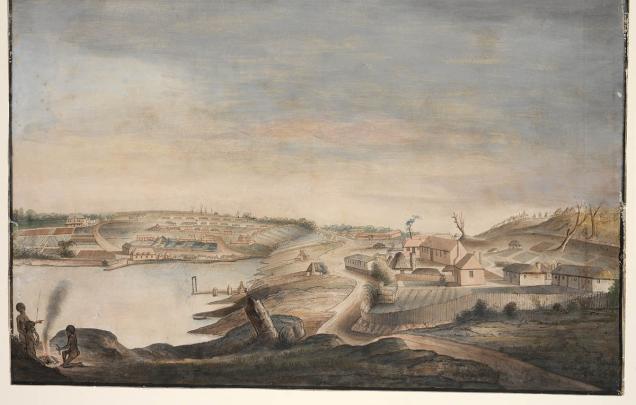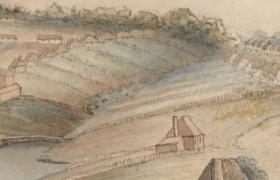Surviving the challenges
Students explore the famine and the challenge of staying healthy and safe in the early colony.

Surviving the Challenges
Keeping healthy is essential for human life.
Brainstorm the basics needs for humans to live healthy lives.
Answer this question:
- How do we ensure we have these things today?
Humans need food to survive, and famine was an ongoing threat to the colony due to irregular supplies and the inability to produce or find enough fresh food. Despite ships being sent across the oceans to bring back extra supplies, food was a focus for everyone. This was not just feeling a little bit hungry, this was a serious threat to the health and lives of everyone in the colony.
Read Captain Watkin Tench’s comments in April 1791:
I every day see wretches pale with disease and wasted with famine, struggle against the horrors of their situation.
With the colonists affected by famine, their bodies were more susceptible to illness. Food storage and preservation was also a challenge.
Read an extract from the account of free settler George Thompson, written in 1792:
The musquittoes and flies are in great quantities; the latter will infect fresh meat in such a manner that it is sometimes difficult to keep it free from maggots even one hour after it is killed.
Answer these questions:
- What are maggots and how do they infect meat?
- Could they keep the food safe so it would not endanger their health?
- What do we do today that could have solved their problem of safe food storage? [See suggestions in Additional Information.]
Contaminated food and water sources cause serious health issues and would have been an ongoing problem for the colony. There are many illnesses caused by food contaminated with bacteria, parasites, viruses or toxins. Many of these would not have been known to doctors at this time.
There were no toilets in the colony as we think of them today. Instead people used a pit toilet (or cesspit). If you have been camping or live rurally you might have used one yourself. This was basically a hole dug in the ground that was used by many people. All sorts of other rubbish, like animal bones and rotten food, would also be tipped into it too. When the cesspit was full, the people stayed in the same place, but the ‘toilet’ moved and a new hole was dug. The soil under and around a cesspit could become contaminated, and this could make its way into nearby water. In this case, this included the fresh water the colony depended on, like the Tank Stream in the middle of the settlement. It is worth noting that conditions in towns in Britain/Europe at this time were similar in terms of sanitation and health.
Look at this image of the houses at the top of the hills (in the background) and the slope down to the Tank Stream painted in 1794.

- Why was it not a good idea to locate toilets at the top of the hill? [Answer in Additional Information.]
- After living in the settlement for a few years would you want to drink the water or wash your clothes in the Tank Stream?
- How do you think the Aboriginal people would have felt about the contamination of the fresh water they had been using and managing for millenia?
Aboriginal people understood the importance of clean water. They would toilet away from water sources and then move campsites regularly, not returning to the same place for several months at least. They had complex knowledge of how water sources were connected and saw the protection of fresh water sources as one of their obligations.
Discuss how life with communal pit toilets is different to living in a house today, and the challenges in keeping the toilet waste separate to the drinking water. Some of you may know about this already if you live somewhere which isn’t on town water or have been in a flood, or have had plumbing work done at home.
Considering the brainstorm at the beginning of this task about human requirements for healthy living, such as, access to clean water, nutritious food and somewhere safe to sleep.
Answer these questions:
- Do you think the people who arrived with the First Fleet had access to these things?
- Did Aboriginal people have access to them?
Another challenge to survival for convicts was avoiding being killed whilst at work. Convicts were often sent out in the bush to collect native greens to eat, or to cut rushes for roof thatching or even to cut wood for hut building. Soldiers walking the roads outside of Sydney Town would carry guns. Convicts had no weapons to protect themselves. Conflict occurred between convicts and Aboriginal people, often for many complex reasons.
Read Lieutenant William Bradley’s record of what happened on 10 March 1788:
Some of the Convicts straggling into the woods met with several of the Natives, a quarrel ensued, who were the agressors is hard to say, but the Convicts were some of them wounded & one since dead.
On 30 May 1788 two convict men, William Okey and Samuel Davis, were cutting rushes (that were used to thatch roofs) at a place up the harbour, identified by one researcher as White Bay. An officer came across their dead bodies. We can assume that one of them was killed by Aboriginal people due to the three spears found in his body.
Read Surgeon John White’s response,
What was the motive… we have been unable to discover, but… I am strongly inclined to think that they [Aboriginal people] must have been provoked and injured by the convicts.
Answer these questions:
- Why do you think the convicts were injured and killed?
- Could these injured or killed convicts have done anything differently?
- How do you think other convicts in the colony felt after these deaths?
- Is killing justified?
[For more information on Aboriginal and colonist conflict and the Frontier Wars see the Fighting Back learning activity.]
Convicts in the early colony could not trust each other. A convict named John Lewis was killed on 5 January 1794 whilst looking after cattle in the Parramatta area.
Read Judge David Collins’ record of what John Lewis had done:
[He had] boasted of being worth much money, and that he always carried it with him sewed up in some part of his clothes, to guard against losing it while absent from his hut.
A post-mortem concluded that John Lewis was killed by more than one attacker. His murder was never solved but it was suspected that convicts he knew and had gambled with were responsible.
Answer these questions:
- Why would the killers risk being caught and possibly put to death themselves?
- What could John Lewis have done differently?
- It is possible that other convicts knew or suspected who the murderers were. Why do you think they didn’t tell the authorities?
- How do you think other convicts in the community felt after John Lewis’ murder?
- Is killing justified?
As a class create a word cloud of all the possible words to describe the challenges to survival of First Fleet convicts. Use a thesaurus to help you find the perfect words. Add more words after doing Activity 2 and 3. Print and display the word cloud in your classroom.
Continuing activity for individual students: Choose one word that best describes the situation to you. Draw the letters in LARGE bubble writing. Draw illustrations inside the letters reflecting the convicts’ experiences. Display these words in your classroom to remind you of the hardships and threats they encountered.